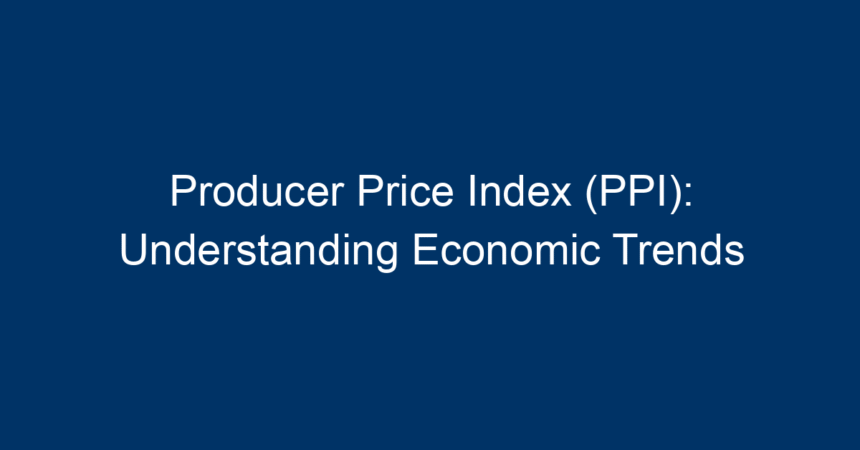Introduction
In the complex world of economics, indicators play a crucial role in helping analysts, policymakers, and business leaders gauge the health of the economy. One of the most important of these indicators is the Producer Price Index (PPI). Understanding the PPI can provide valuable insights into inflation trends, production costs, and overall economic health. In this article, we will delve into what the PPI is, how it functions, and why it is essential for understanding economic trends.
What is the Producer Price Index (PPI)?
The Producer Price Index (PPI) measures the average change over time in the selling prices received by domestic producers for their output. Unlike the Consumer Price Index (CPI), which tracks price changes from the perspective of consumers, the PPI reflects changes in prices from the standpoint of the supplier. It serves as a critical gauge for businesses and economists to understand inflationary trends and cost pressures in the economy.
Breakdown of the PPI
The PPI is categorized into various sectors, allowing for a granular analysis. These sectors include:
- Goods: This includes durable goods, nondurable goods, and energy products.
- Services: Featuring a wide range of service industries from transportation to healthcare.
- Construction: Tracks price changes in construction materials and services.
Each category provides essential data that can influence decisions across multiple sectors of the economy.
How is the PPI Calculated?
The PPI is calculated using data collected from thousands of producer surveys across diverse industries. The Bureau of Labor Statistics (BLS) in the United States compiles this data monthly.
Key Calculation Processes
- Data Collection: Producers are surveyed regarding the prices they receive for their goods and services.
- Weighting: Prices are then weighted according to their importance in the economy, ensuring that significant sectors have a more substantial impact on the index.
- Index Calculation: The weighted prices are converted into indices to reflect price changes over shorter intervals compared to historical data.
Why is the PPI Important?
Understanding the Producer Price Index (PPI) is essential for several reasons:
Inflation Indicator
The PPI serves as a leading indicator of inflation. A rising PPI suggests that producers are facing increasing costs, which may eventually be passed on to consumers in the form of higher prices, potentially stoking inflation. This relationship is crucial for economic forecasting and understanding market dynamics.
Business Decision-Making
Businesses rely on the PPI when planning their strategies. For instance, if the PPI is rising significantly, companies might reconsider their pricing structures or adjust their production levels to mitigate cost pressures. An understanding of PPI trends enables firms to align their operations more closely with broader economic conditions.
Economic Policy Formulation
Governments and policymakers use the PPI to shape economic policies. If the PPI indicates rising costs, policymakers may consider adjustments in monetary policy, such as changing interest rates to stabilize inflation. The PPI, therefore, plays a vital role in formulating fiscal and monetary policies.
PPI vs. CPI: Key Differences
While both the PPI and CPI are crucial indicators of economic health, they serve different purposes and reflect distinct aspects of the economy.
Perspective
- PPI: Measures prices from the perspective of producers.
- CPI: Measures prices from the perspective of consumers.
Focus
- PPI: Primarily focuses on wholesale prices before goods and services reach consumers.
- CPI: Primarily focuses on retail prices that consumers pay.
Price Changes
- PPI: Can provide early signals of inflation, as producers may adjust their prices before reaching the consumer level.
- CPI: Reflects the final cost to consumers and can lag behind PPI trends.
Analyzing PPI Trends
To make informed decisions based on PPI data, users must analyze the trends over time. Here’s how to interpret PPI movements effectively.
Long-term Trends
Observing long-term PPI trends can provide insights into the underlying economic conditions. For instance, consistent increases over several months or years may signal persistent inflationary pressures.
Monthly Changes
Monthly changes can often provide immediate insights into economic activity. A sudden spike in the PPI could indicate supply chain challenges, increased production costs, or surging demand, urging businesses to adjust their strategies quickly.
Sector-Specific Trends
Diving deeper into sector-specific data can reveal localized economic pressures. For example, if the PPI for agricultural goods rises while the general PPI remains flat, it may indicate specific supply shortages or increased demand in that sector.
Actionable Insights from PPI Data
Understanding the Producer Price Index (PPI) can lead to actionable insights for various stakeholders:
For Businesses
- Pricing Strategies: Adjust pricing strategies proactively based on anticipated changes in the PPI.
- Cost Management: Identify which areas of production are most susceptible to price increases and manage them accordingly.
- Investment Decisions: Analyze sectors showing growth or volatility in the PPI to make informed investment decisions.
For Investors
- Market Timing: Use PPI data to time investments in stocks or bonds, as changes in inflation expectations can affect asset prices.
- Sector Allocation: Adjust portfolios based on which sectors are expected to outperform or underperform relative to PPI trends.
For Policymakers
- Monetary Policy: Use PPI data to inform decisions on interest rate adjustments to control inflation.
- Economic Forecasting: Incorporate PPI trends into broader economic models for more accurate forecasting and planning.
Conclusion
The Producer Price Index (PPI) is a vital economic indicator that provides insights into inflationary trends, production costs, and overall economic health. By understanding the PPI and its implications, businesses can adapt their strategies, investors can make informed decisions, and policymakers can craft effective economic policies.
As we move forward, staying updated on the PPI and its movements will be essential for navigating the economic landscape successfully. By keeping an eye on this key indicator, stakeholders across the board can gain a clearer understanding of economic trends and make more informed decisions. Whether you are a business leader, investor, or policymaker, the PPI should be a critical component of your economic toolkit.
This structured approach to the Producer Price Index (PPI) highlights its importance and provides actionable insights, ensuring that readers clearly understand its role in economics.




